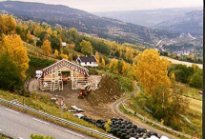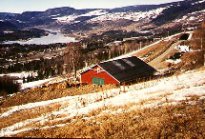
Fall 96. View from the main house

Interior

Spring 97.View from the south
| - Kaldor Farm Virtual Tour - |
The New Barn |
| Previous | Next | Virtual Tour Start | Kaldor Farm Homepage |
We bought our first beef cattle in 1991. Due to the harsh Norwegian climate, we have to provide the herd with a shelter most of the year. Until 1996 this was an old barn situated at some distance below the farm, accessible only by foot most of the year. This was clearly no lasting solution, neither for the cattle nor for us.
The planning for a new cattle shed started in 1993/94. The old barn from 1920, that housed dairy cows until 1963 and sheep until 1971, was deemed inadequate for the purpose. One reason was that it would need substantial renovation in order to facilitate modern cattle handling methods. The rennovation costs would equal those of building a new barn, and further expansion would be close to impossible. Another reason was the establishment (in 1988) of the Hafjell Alpine Center, which left us with less than 3 meters between the old barn and the skiing slopes and no direct access to the rest of our land. There was no way we could use the old barn and provide the herd with a decent outdoor area, nor find enough space to make the use of a tractor when feeding and cleaning anything less than a safety hazard.
As can be seen from the pictures, Kaldor is a steep farm. The only remaining area flat enough to erect a building on was across the road to the south and below the main farm. In 1996 we finally got the permission to build a new barn at this site.
In september 1996 the building started, under the auspices of a neighbor and good friend, Řystein Ihle. The barn measures 17*14 meters and is a steel and wood construction, built to fit into the landscape and match the other buildings on the farm. The steel construction was delivered by Petmas Landbruksservice. It is possible to expand the barn further, to 34*14 meters. Total investment costs so far is close to 500.000 NOK (approx. 75.000 USD).
The barn is uninsulated and has no means of heating. The main purpose is to give the herd shelter from wind, rain and snow. In winter the cows are kept warm by their thick fur, and by the talle, e.g. the mixture of dung and hay that builds up during the cold season. The temperature within the talle can reach as high as 70 degrees C.
Building a new barn, we also have had to cope with a number of regulations, especially dealing with environmental issues. We have recently been granted permit for our plan to feed the cattle outdoors, so that they mainly use the barn for sleeping.
The remaining work, which consist of enlarging the flat, outside area and establishing a storage place for the dung, is planned for the summer of 1997.
We believe this way of cattle production to be particularly well suited to the Norwegian climate and nature, being both environmentally sound and cost efficient. In addition it gives us much joy!